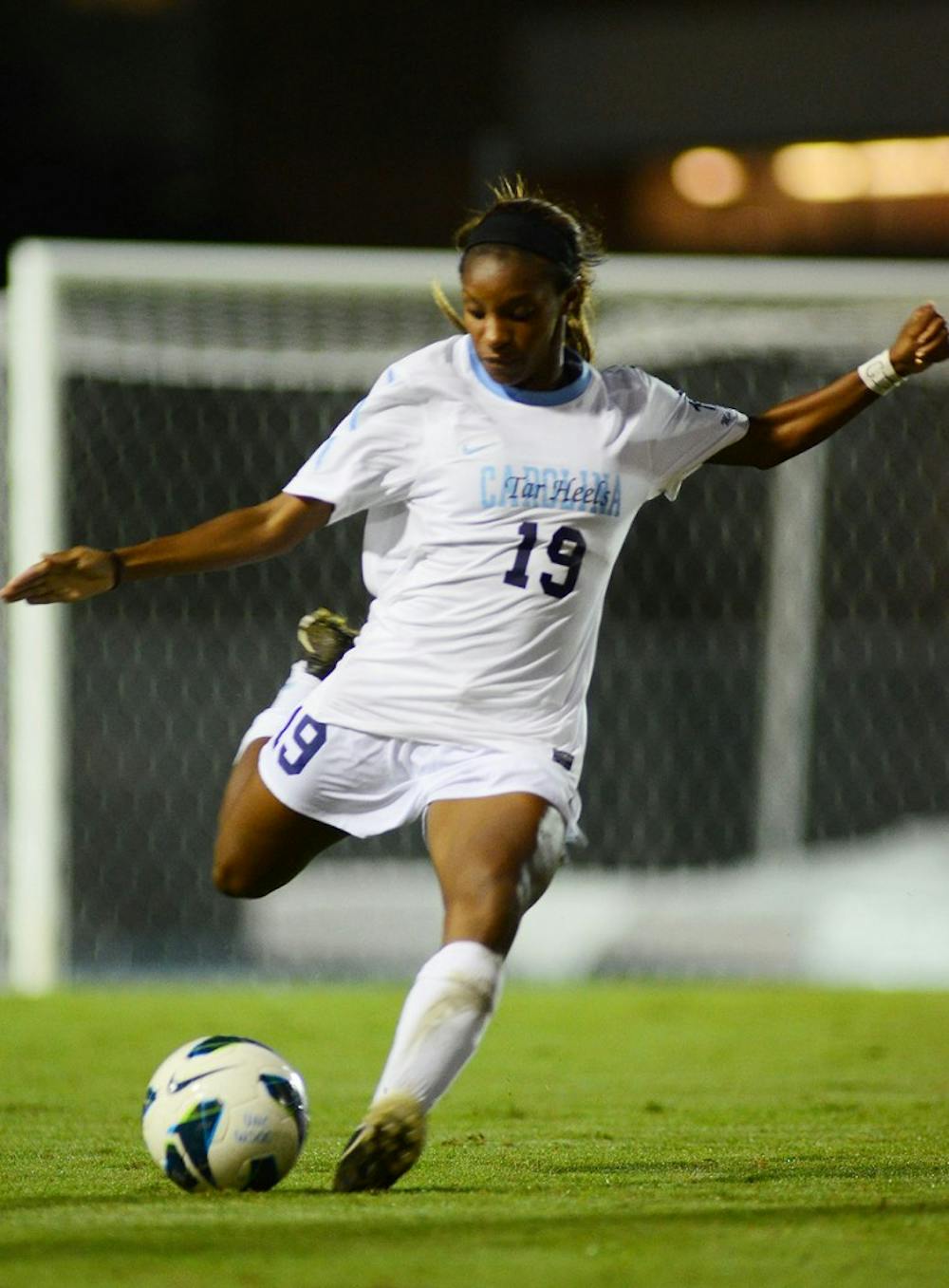“Speed is a key factor for us,” Dunn said. “It throws teams off balance when all our speed is in the attacking seven players. So if I’m thrown up top it’s basically for an advantage with speed.”
But the 3-4-3 can also be vulnerable without a strong defense, because there are only three players back — as opposed to the 4-2-3-1, a system UNC occasionally uses that has four defenders.
For much of the season, the Tar Heels needed Dunn to steady the three-player back line. They didn’t have enough defensive flexibility to use her on offense.
Senior defender Megan Brigman has been out all season with a fractured leg, and sophomore defender Caitlin Ball missed more than a month with an injury.
Shorthanded in a formation that requires extra effort from defenders, UNC needed Dunn to solve its defensive problem more than it needed her on the attack.
Dunn’s versatility has allowed UNC to stay with the 3-4-3 despite the injuries.
“Because she can play three positions, it enables us to play the 3-4-3 more often instead of having to adopt into the 4-2-3-1,” senior midfielder Amber Brooks said. “That’s what we’re most comfortable in, and we like to get after teams in that system. We’re high-pressure.”
Postseason positioning
Dunn played most of the season at center back. But in North Carolina’s first-round NCAA Tournament match against Radford on Saturday, she started at midfield. In the second half, the Tar Heels moved her up to forward.
Ball was back at full strength, giving Dorrance the freedom to run Dunn up front. Dunn scored the second goal in UNC’s 2-0 win.
And Dorrance said that with Ball healthy, he plans to keep Dunn attacking — either from the midfield or forward position — the rest of the way. But the Tar Heels could always move her back to defense if necessary.
“Obviously if we’re up by a goal or two and we’ve got to salt away the rest of the game, there’s a possibility we can throw her in the back to secure us,” Dorrance said. “That’s always a tactical option for us.
To get the day's news and headlines in your inbox each morning, sign up for our email newsletters.
“But she’s such a good attacking player and the hardest thing to do in this game is attack, create and score goals. Using her in those positions is just a better use of our personnel.”
Dunn did say after the Radford game that she was surprised Dorrance didn’t put her back on defense after UNC went up 1-0.
And Dorrance said that if the Tar Heels made it to the later rounds of the tournament and ended up playing a top team like Stanford — the current No.1 team in the country — Dunn would see some time on defense. But not 90 minutes.
“I’d probably start her at center back, then 15 to 20 minutes into the game shift her to either attacking center half, flank midfield or up top,” Dorrance said. “We would want to weather the initial parts of the game to make sure we felt secure against the Stanford attack. And once we felt secure, we would move her and cause Stanford problems.
“Trust me, wherever we would put her, it doesn’t matter who Stanford has there, she would dominate her opponent.”
But before UNC can think about advancing deep into the tournament, it has to get past Illinois tonight at 6:30 on Fetzer Field.
‘A good compromise’
Dunn’s job is to balance out the North Carolina formation. But when she moves from one spot to another, it’s difficult to maintain that balance — the Tar Heels get worse at whatever position she leaves.
But Dunn said playing at multiple positions might actually throw other teams off more than it hurts the Tar Heels.
“I just want to be needed on the field,” Dunn said. “I can’t even claim a position right now. I mold well with the team wherever I’m playing, so I feel like it’s good for us to keep changing things up and keeping teams on their toes.”
Her teammates aren’t exactly sure where they want her to play, either.
Brooks said she feels comfortable when Dunn is behind her on defense, loves playing with her at midfield and sometimes gets caught watching her when she’s making moves on offense.
Ohai echoed Brooks’ feelings and also said that while Dunn is a problem-solver, she is also a problem-creator for other teams wherever she plays.
“They have to change their lineup to fit to her,” Ohai said.
Dorrance said that no matter what Dunn’s job is on a given day, she gets it done.
He also said that although the Tar Heels lose their best defender when Dunn plays up, her offensive skill outweighs the risk of leaving her off the back of the 3-4-3.
“We certainly lose something when we don’t play her back there, but we gain so much more when we play her farther forward,” Dorrance said. “It’s worth it. It’s a good compromise for us.”
Contact the desk editor at sports@dailytarheel.com.



